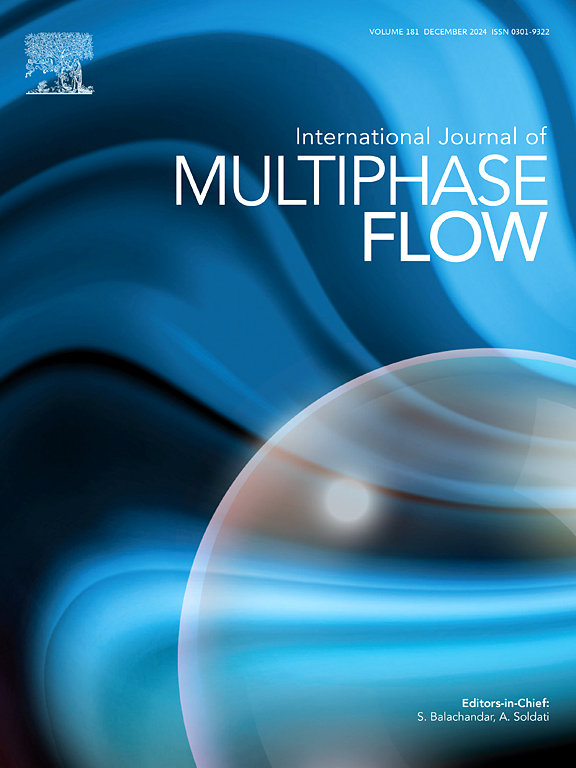Impact of wall-normal external force on particle collision dynamics in turbulent channel flow
IF 3.8
2区 工程技术
Q1 MECHANICS
International Journal of Multiphase Flow
Pub Date : 2025-06-27
DOI:10.1016/j.ijmultiphaseflow.2025.105344
引用次数: 0
Abstract
Particle collision in turbulent channel flow is systematically investigated by a direct numerical simulation coupled with Lagrangian particle tracking. For particles with low inertia (characterized by a viscous Stokes number St+≤5), the external force slightly reduces the particle clustering, while it promotes the radial relative velocity (RRV). The competition between these two mechanisms results in the collision kernel of low-inertia particles being largely unaffected by the wall-normal external force. For heavy particles with St+≥15, a significant reduction in the collision kernel was observed when subjected to the external force. This inhibitory effect increased with the magnitude of the external force ψ and the particle inertia. The radial distribution functions (RDF) of heavy particles display a monotonic decrease with the external force, as the force weakens the interaction between particles and the coherent flow structures. Notably, the RRV of heavy particles exhibits a novel increasing-decreasing trend with the external force. By analyzing the flow structures at the location of colliding particles, we demonstrate that the external force causes faster particles to enter ejection structures, where they collide with slower particles, resulting in an elevation of the relative colliding velocity. Finally, we quantify the contributions of RDF and RRV to the variation of the collision kernel as the external force increased for light and heavy particles.

紊流通道中壁法向外力对颗粒碰撞动力学的影响
采用直接数值模拟与拉格朗日粒子跟踪相结合的方法,系统地研究了湍流通道中粒子碰撞问题。对于惯性较低的粒子(粘性斯托克斯数St+≤5),外力对粒子聚类有轻微的抑制作用,但对径向相对速度(RRV)有促进作用。这两种机制之间的竞争导致低惯性粒子的碰撞核在很大程度上不受壁法向外力的影响。对于St+≥15的重粒子,在外力作用下,碰撞核显著减小。这种抑制效应随着外力ψ的大小和粒子惯量的增大而增大。在外力作用下,重粒子的径向分布函数(RDF)呈现单调减小的趋势,这是由于外力作用减弱了粒子与相干流结构之间的相互作用。值得注意的是,重粒子的RRV随着外力的作用呈现出一种新的增减趋势。通过对碰撞粒子位置的流动结构的分析,我们证明了外力使更快的粒子进入弹射结构,在弹射结构中它们与较慢的粒子碰撞,导致相对碰撞速度的提高。最后,我们量化了随着轻粒子和重粒子外力的增加,RDF和RRV对碰撞核变化的贡献。
本文章由计算机程序翻译,如有差异,请以英文原文为准。
求助全文
约1分钟内获得全文
求助全文
来源期刊
CiteScore
7.30
自引率
10.50%
发文量
244
审稿时长
4 months
期刊介绍:
The International Journal of Multiphase Flow publishes analytical, numerical and experimental articles of lasting interest. The scope of the journal includes all aspects of mass, momentum and energy exchange phenomena among different phases such as occur in disperse flows, gas–liquid and liquid–liquid flows, flows in porous media, boiling, granular flows and others.
The journal publishes full papers, brief communications and conference announcements.

 求助内容:
求助内容: 应助结果提醒方式:
应助结果提醒方式:


